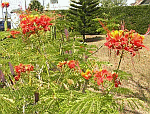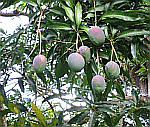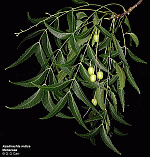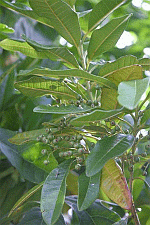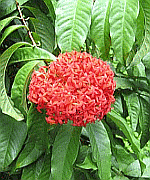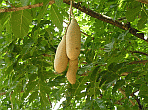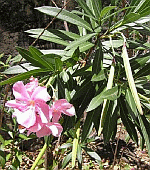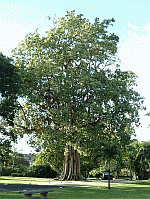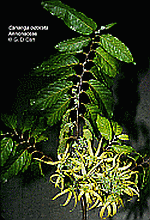 |
Dominica Botanic Gardens Roseau, Commonwealth of Dominica, West Indies |
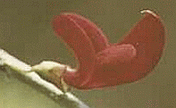 |
| Home Page |Site Coordinator | © Dominica Academy of Arts and Sciences, Dec. 2004 | Gardens Curator/Tour Enquiries |
| Medicinal Plants List |
| SCIENTIFIC NAME | COMMON NAME | PARTS USED | AILMENTS/USES |
|
Red Catstail, Chenelle Plant |
root+flower |
decoction for coughing blood |
|
|
|
|
leaves |
poultice for leprosy |
|
|
|
flower |
diuretic for kidney ailments |
|
|
|
bark |
expectorant and to relieve asthma |
|
|
|
root |
pulmonary problems |
|
Baobab |
seed |
fevers |
|
|
Caribbean Albizia |
roots |
contusions, angina |
|
|
|
|
bark |
scorpion stings |
|
Ginger Lily |
leaves |
stomach complaints |
|
|
Ditta Bark, Pulai |
bark |
malaria, diarrhoea, dysentery |
|
|
Soursop, Kowosol |
leaves |
skin diseases, abscesses, colds, fever, diarrhea, gonorrhea; as sedative, and to induce labor and lactation |
|
|
|
|
bark |
dysentery and worms |
|
Custard Apple, Cashima |
leaves |
diarrhea, fever |
|
|
|
|
bark |
sprains and dislocations |
|
|
|
seeds |
lice |
|
Breadfruit |
leaves |
heart disease, hypertension, diabetes, diarrhea, urinary tract infections |
|
|
|
|
stem exudate |
abscesses, bruises and sprains |
|
Jackfruit |
leaves |
poultice for ulcers |
|
|
|
|
wood |
decoction as sedative |
|
|
|
pith |
decoction as abortive |
|
|
|
root |
decoction for fever and diarrhea |
|
|
|
latex |
poultice for abscesses and snake bites |
|
Neem |
leaf |
antiviral: for flu, colds, herpes, dengue
fever |
|
|
|
|
fruit/oil |
leprosy, rheumatism |
|
Spiny Bamboo |
leaves |
childbirth lochia, vermifuge |
|
|
|
|
young shoot |
expelling worms from ulcers |
|
|
|
root |
urine voiding, cirrhosis, miscellaneous tumors |
|
Bombax, Red Silk Cotton |
roots |
astringent and aphrodisiac |
|
|
|
|
gum |
diarrhea and dysentery |
|
Brownea |
bark |
menorrahgia, menstrual pain |
|
|
Flame of the Forest |
bark/resin |
astringent (tightens/shrinks tissue) |
|
|
Barbados Pride |
root, leaf, flower, seed |
gall and kidney stones, childbirth, abortifuge |
|
|
Ylang Ylang |
flowers/oil |
aroma therapy, slows rapid breathing |
|
|
Golden Shower |
root, bark, fruit |
purgative, astringent |
|
|
Cinnamon, Canelle |
bark |
tea for abdominal complaints |
|
|
|
|
leaf |
tea to reduce fever |
|
|
|
bark & leaf oil |
antiseptic and astringent |
|
|
|
bark powder |
ingested for diabetes |
|
Balsam, Copaiba Balsam |
sap (resin) |
Topically: stop bleeding, heal wounds, psoriasis. Internally: bronchitis, gonorrhea, among others |
|
|
Sago Palms |
various |
cancers, tumors, rheumatism |
|
|
Tonka Bean, Cumaru |
bark |
fever |
|
|
|
|
Seed |
snakebites, cuts, coughs and rheumatism |
|
|
|
Seed oil |
earaches and ear infections |
|
African Oil Palm, Oil Palm |
oil |
for Vitamin A deficiency, as liniment, aphrodisiac, diuretic, for cancer, headache, rheumatism |
|
|
Campeche, Logwood |
bark, leaves |
astringent, anemia, dysentery, diarrhea |
|
|
Ixora |
flowers, leaves, bark |
blood-shot eyes, sores, ulcers |
|
|
Bermuda Juniper |
shoots/oil |
diuretic (promotes urination) |
|
|
Sausage Tree |
fruit |
purgative, in dressing wounds, ulcers |
|
|
Queens Flower Tree |
seeds, leaves |
seeds narcotic, leaves purgative |
|
|
Litchi, Lychi, Litchee |
fruit |
chronic coughing, stomach ache |
|
|
|
|
fruit skin |
tea for smallpox, diarrhea |
|
|
|
seeds |
powdered for neuralgic pain |
|
Mango |
flowers |
astringent for diarrhea and dysentery |
|
|
|
|
leaves |
diarrhea, fever, diabetes |
|
|
|
seed |
intestinal worms |
|
|
|
bark/latex |
rheumatism, diphtheria, syphilis |
|
Paperback Tree |
leaves & twigs (oil) |
Topically – headaches, thrush, vaginal infections, acne, insect bites, among others; Internally – cystitis, glandular fever, chronic fatigue, among others; |
|
|
Noni, Pangkila |
leaves |
rheumatism, wounds, fever, headaches, laxative |
|
|
|
|
fruit |
asthma, lumbago, dysentery, cancer, fractures, menstruation |
|
|
|
bark |
jaundice, hypertension, laxative |
|
|
|
seed |
laxative, head lice |
|
Banana, Lacatan, Cavendish Banana |
stem |
pulp infusion for dysentery |
|
|
|
|
leaves |
burns, dysentery, diarrhea, malignant ulcers |
|
|
|
flowers |
cooked for bronchitis, dysentery, diabetics |
|
|
|
ripe peel |
abortive, salve for insect stings and bites |
|
|
|
unripe peel |
ashes for dysentery, malignant ulcers |
|
|
|
sap |
epilepsy, leprosy, dysentery |
|
|
|
root |
carbuncles, digestive disorders and dysentery |
|
Oleander |
sap (toxic) |
skin diseases |
|
|
Screwpine |
leaf |
reduce external swelling |
|
|
Avocado, Pear, Zaboca |
leaves |
pyorrhea, neuralgia, diarrhea, wounds, menstruation |
|
|
|
|
new shoots |
coughs, abortifuge |
|
|
|
fruit skin |
vermifuge, dysentery |
|
|
|
seed |
diarrhea, dysentery, toothache |
|
Blue Petrea |
leaves |
abortifuge, diarrhoea |
|
|
Allspice, Pimento |
leaf/oil |
toothache anesthetic |
|
|
Zanana Falaise, Batard Lapite |
scales on leaf underside |
burns, thrush, heal infant navel |
|
|
Saraca, Ashoka Tree |
bark |
uterine cramps, bleeding & fibroids |
|
|
Teak |
wood, flowers |
hemorrhoids, bronchitis |
|
|
Mahot LaMer, Portia Tree |
bark |
skin diseases, dysentery and hemorrhoids |
|
|
|
|
Leaves |
inflamed and swollen joints, open ulcers |
|
|
|
Sap |
ringworm and other skin diseases |
|
Bois Lezard, Huleumele |
bark |
Topically for ulcers |
| © Dominica Academy of Arts and Sciences, Dec. 2004 | Home Page | Comments & Suggestions |Site Coordinator | Gardens Curator/Tour Enquiries |
